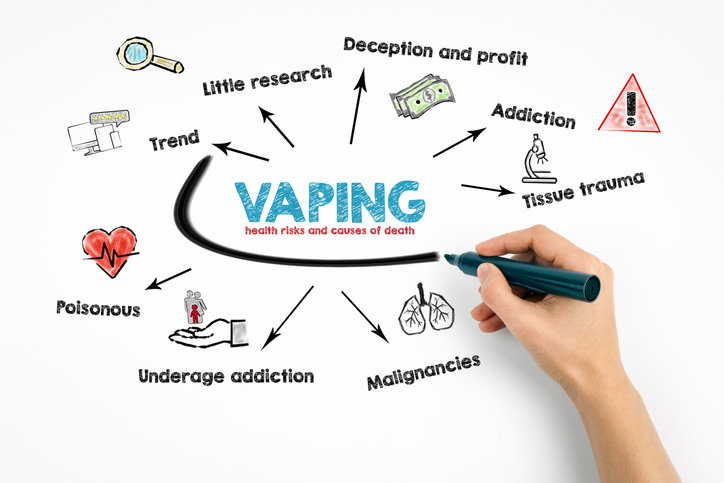It might look like a pen, a USB flash drive, or its just-as-dangerous sibling, the cigarette. No matter what form it takes, one thing is clear — electronic cigarettes are dangerous, and they are apparently here to stay.
Vaping, which is the use of e-cigarettes, has taken the country by storm. These small-but-mighty devices heat a liquid, creating an aerosol for inhaling. Inside that liquid is flavoring, plenty of harmful chemicals, and in most cases, nicotine.
Susan Pizzi, MS, RN,
Community Health Education Coordinator
Despite numerous warnings over the past few years from the Centers for Disease Control and Prevention (CDC) that vaping is unsafe for children, teens, and young adults, it's more popular than ever.
"Vaping is putting the health of millions of Americans at risk, especially teens and young adults. Whether its popularity is due to targeted advertising, peer pressure, or lack of awareness, vaping needs to move from the back seat to the front, where it can get the attention it deserves," says Susan Pizzi, MS, RN, a community health education coordinator at Chester County Hospital who manages the hospital's
"Stop Smoking Now!" smoking cessation program.
Here's what you need to know about vaping — and how the US is fighting back to protect its youth.
Vaping 101: What Is It and Why Is It Harmful?
In January 1964, the Surgeon General of the United States released its first-ever report on smoking, pointing to it as a cause of lung cancer and chronic bronchitis.
Since then, despite the continued efforts of the government to spread awareness and enact anti-smoking laws, more than 45 million Americans still smoke. On top of that, around 438,000 die each year as a result of tobacco use.
"Now, the nation's focus has turned to electronic cigarettes, which many used to view — or still view — as the safer alternative to the cigarette. But e-cigarettes can be just as harmful and, at this rate, may end up being more popular than cigarettes themselves," adds Pizzi.
 What Are E-Cigarettes?
What Are E-Cigarettes?
You might hear them referred to as e-cigs, vape pens, or JUULs (a brand of e-cigarettes), and you might see them resemble a USB drive, a smartphone case, or a lipstick tube.
No matter what they're called or what they look like, e-cigarettes all function the same way. They heat a liquid to produce an aerosol (small particles in the air), which contains nicotine, flavoring, and plenty of other dangerous chemicals.
To get the impact of the e-cigarette, all the user needs to do is inhale the aerosol. When they exhale, bystanders also run the risk of inhaling some of those dangerous ingredients.
While e-cigarettes are made for nicotine, they can also be used to smoke marijuana and other drugs — a trend that is becoming more and more popular each year.
Why Are E-Cigarettes Unsafe?
The primary reason e-cigarettes are dangerous for children, teens, and young adults comes down to one ingredient: Nicotine. Up to 99% of e-cigarettes contain this harmful and addictive ingredient, which is also found in regular cigarettes, cigars, and other tobacco products.
Unfortunately, some labels don't disclose it even when they do contain nicotine.
When young people use nicotine, it can damage their brain, which is developing until about age 25. More specifically, it's harmful to the parts of the brain in charge of:
- Attention
- Learning
- Mood
- Impulse control
The Latest on the Dangers of E-Cigarettes
The dangers of nicotine have been known for years. Now, due to an increase in vape-related hospitalizations, another serious risk of vaping is becoming clear: E-cigarette, or Vaping, Product Use-Associated Lung Injury (EVALI).
In August and September 2019, EVALI cases spiked dramatically in the US. By January 2020, 2,668 hospitalized cases or deaths from EVALI were reported by the CDC.
The EVALI outbreak confirmed what many people have feared for years — the dangers of vaping don't end with nicotine. Serious health risks come from the very additives many people previously brushed off as being harmless.
Thanks to increased awareness of the dangers of vaping after the outbreak, hospitalizations from EVALI have been declining. However, states are continuing to report new EVALI cases and deaths on a weekly basis.
Not everything is known about vaping, and there may be dangers yet to come. What is certain, however, is that the CDC and the US Food and Drug Administration (FDA) strongly recommend against using e-cigarettes — ever.
The Power of Knowledge and Conversation
Whether a teen or young adult starts vaping because of the flavor options (such as chocolate or fruit and crème) or the perception that e-cigarettes are less harmful, the fact remains that they are.
To help prevent youth tobacco use, Pennsylvania has become the 19th state to raise the minimum age for the purchase of tobacco and nicotine products from 18 to 21, which went into effect July 1, 2020. The law also aims to reduce the number of health problems associated with vaping amid rising vaping-related illnesses, and prohibits e-cigarette and related products on school grounds.
Now more than ever, vaping education is critical. Prevention programs, such as the US Food and Drug Administration's "Real Cost" campaign or Chester County's Tobacco-Free Coalition are just the start of the movement.
Just as important is the role of family members, supportive friends, and caring healthcare providers. Vaping is a force to be reckoned with — but it's nothing against meaningful conversations geared toward awareness, prevention, and the safety of America's youth.
Are you looking to quit smoking? Join our free smoking cessation program, Stop Smoking Now!, which uses behavior modification and relaxation techniques to help participants become nonsmokers during the seven-week program. Call 610-738-2300 for more information or learn more online.
Related Information from Chester County Hospital: